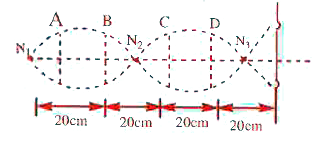A stretched string of length 200cm supports a stationary wave with points having a displacement amplitude of mm being separated by equal intervals of 20cm. To which overtone do these vibrations belong.

5
4
6
3
The correct Answer is:B
Step by step video & image solution for A stretched string of length 200cm supports a stationary wave with points having a displacement amplitude of mm being separated by equal intervals of 20cm. To which overtone do these vibrations belong. by Physics experts to help you in doubts & scoring excellent marks in Class 12 exams.
Topper's Solved these Questions
- BOOK - AAKASH SERIESCHAPTER - WAVESEXERCISE - EXERCISE-II (Strings (Speed of a travelling wave:))23videos
WAVES
- BOOK - AAKASH SERIESCHAPTER - WAVESEXERCISE - EXERCISE-II (Velocity of Sound:)8videos
WAVES
- BOOK - AAKASH SERIESCHAPTER - WAVESEXERCISE - EXERCISE-IB (Assertion (A) & Reason (R) Type Questions)72videos
WAVES
- BOOK - AAKASH SERIESCHAPTER - WAVE OPTICSEXERCISE - PROBLEMS (LEVEL - II)33videos
WAVE OPTICS
- BOOK - AAKASH SERIESCHAPTER - WAVES OPTICSEXERCISE - EXERCISE -III (POLARISITION)10videos
WAVES OPTICS
Similar Questions
A string 120cm in length sustains a standing wave, with the points of the string at which the displacement amplitude is equal to 3.5mm being separated by 15.0cm. Find the maximum displacement amplitude. To which overtone do these oscillations correspond ?
View SolutionA string 120cm in length sustains a standing wave with the points of the string aat which the displacement amplitude is equal to 3.5mm being separated by 15.0cm. Find the maximum displacement amplitude . To which overtone do these oscillations correspond ?
View SolutionA string 120cm in length sustains a standing wave with the points of the string aat which the displacement amplitude is equal to 3.5mm being separated by 15.0cm. Find the maximum displacement amplitude . To which overtone do these oscillations correspond ?
View SolutionA harmonic wave is travelling on a stretched string . At any particular instant , the smallest distance between two particles having same displacement , equal to half of amplitude is 8cm. Find the smallest separation between two particles which have same values of displacement (magnitude only) equal to half of amplitude.
View SolutionTwo identical pith balls are charged by rubbing against each other. They are suspended from a horizontal rod through two strings of length 20 cm each, the separation between the suspension points being 5 cm. in equilibrium, the separation between the balls in 3 cm. Find the mass of each ball and the tension in the strings. the charge on each ball of a magnitude 2.0×10−8C.
View SolutionA stretched string is fixed at both its ends. Three possible wavelengths of stationary wave patterns that can be set up in the string are 90 cm, 60 cm and 45 cm. the length of the string may be
View SolutionIn stationary waves, distance between a node and its nearest antinode is 20 cm . The phase difference between two particles having a separation of 60 cm will be
View SolutionA standing wave is created on a string of length 120m and it is vibrating in 6th harmonic. Maximum possible amplitude of any particle is 10cm and maximum possible velocity will be 10cm/s. Choose the correct statement.
View SolutionA wave travels along the positive x-direction with a speed of 20ms−1. The amplitude of the wave is 0.20 cm and the wavelength 2.0 cm. (a) Write a suitable wave equation which describes this wave. (b) What is the displacement and velocity of the particle at x = 2.0 cm at time t = 0 according to the wave equation written ?
View SolutionTwo sound waves of frequencies 100Hz and 102Hz and having same amplitude 'A' are interfering. At a stationary detector, which can detect resultant amplitude greater than or equal to A. So, in a given time interval of 12 seconds, finds the total duration in which detector is active.
View Solution

